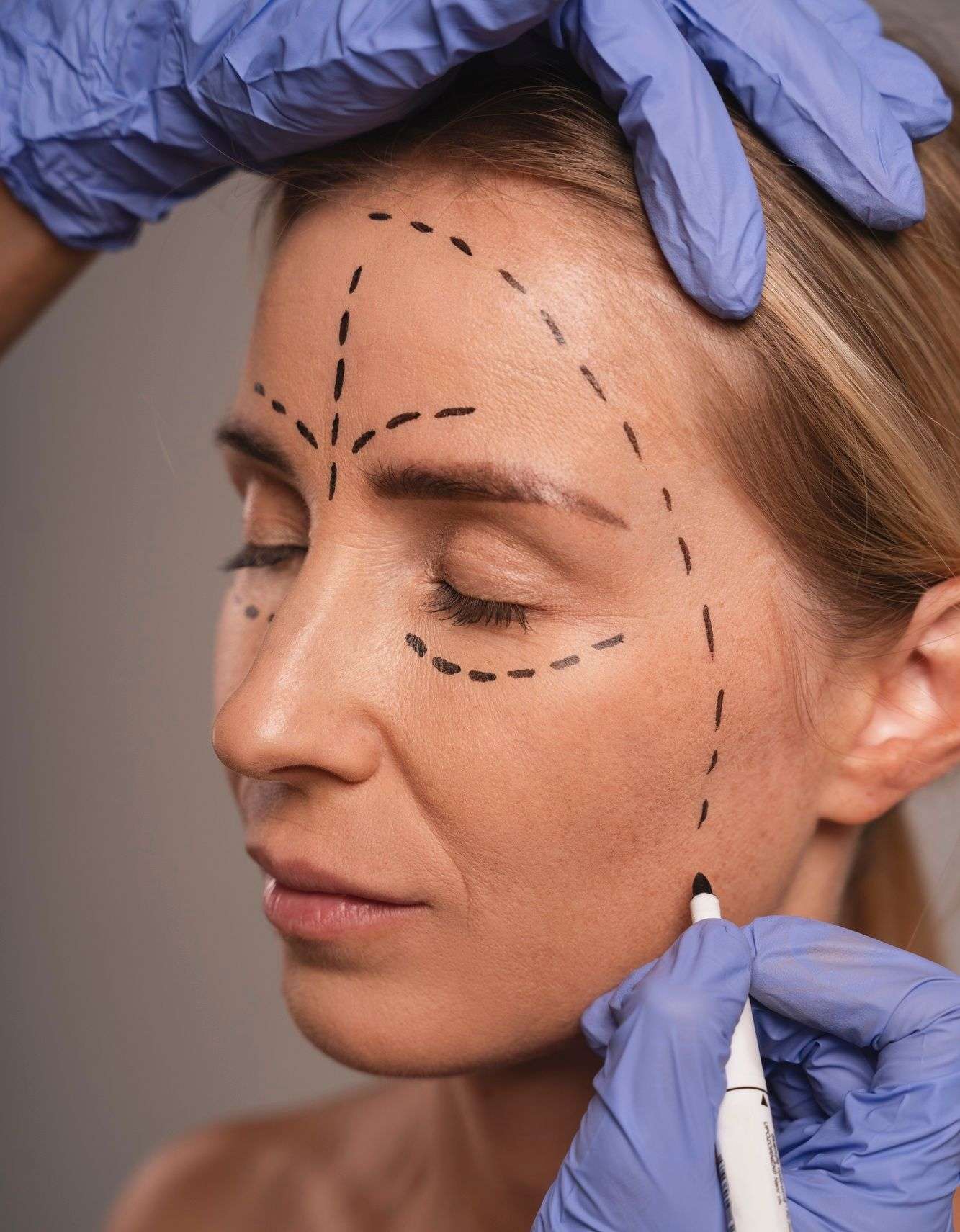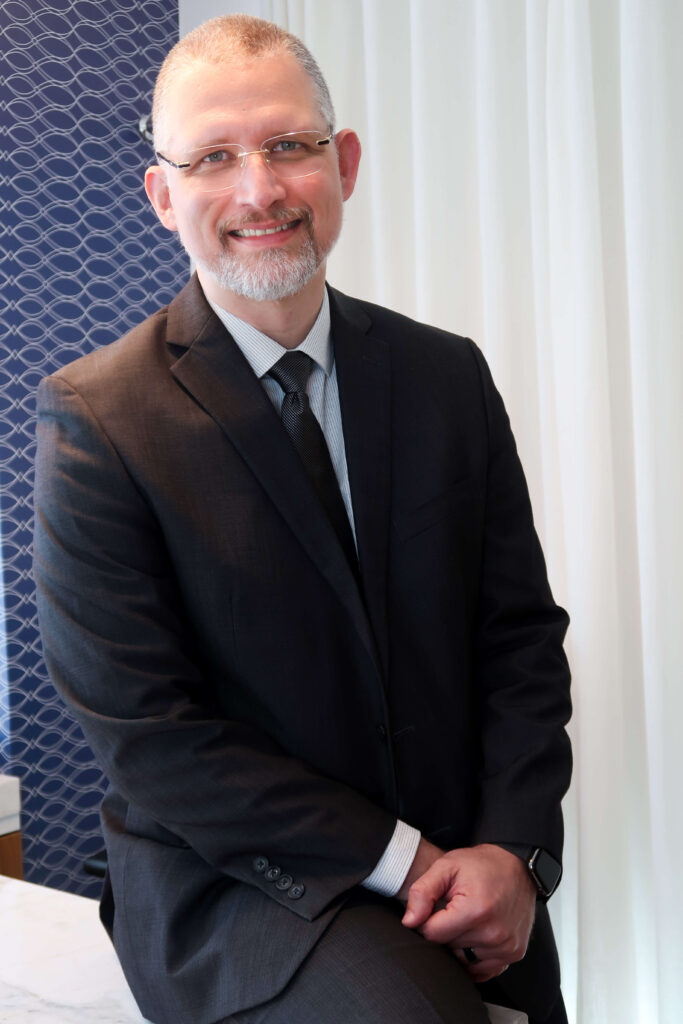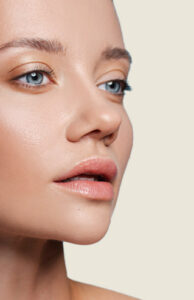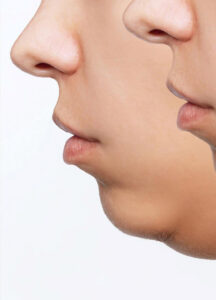

Facelift
Rhytidoplasty - Facial Rejuvenation
Rhytidoplasty surgery involves the removal and repositioning of facial tissues in order to delay the effects of ageing and achieve aesthetic harmony.
The forehead, eyelids, cheeks, lips, chin and neck can all be treated. Each region has its own specific approach, which can involve skin resection, repositioning of structures, fillers and peels. The scars are positioned in areas covered by hair or natural skin folds and are usually barely noticeable.
During Rhytidoplasty we work on the configurations of the facial muscles and skin, shaping them within a certain limit imposed by the individual anatomy and life history of each patient.
Once the deep structures have been reconfigured, we adjust the skin over them.
Complete rhytidoplasty
It covers the entire length of the face and neck, from the temples to the neck. It is indicated for cases of moderate to severe ageing.
Mini-lift rhytidoplasty
Rhytidoplasty is performed under general or local anesthesia, depending on the extent of the procedure. The incisions are usually made along the scalp and around the ears.
The surgeon then repositions the muscles and subcutaneous tissues, removes excess skin and sutures the incisions. The procedure is less extensive, focusing mainly on the lower face and neck.
Suitable for mild cases of sagging and wrinkles.
Rhytidoplasty brow lift
Known as a brow lift, it aims to elevate the eyebrow area and smooth out frontal wrinkles.
Further information about Facial Rejuvenation
- Surgical planning often involves the use of photographs that are studied with an emphasis on individual complaints and personal characteristics. At no point can these resources be considered as predictors of a possible final outcome. These are just resources to facilitate surgical planning.
- Depending on each case, it may be necessary to carry out complementary procedures in the search for a better result. This result depends on individual characteristics and can never be guaranteed in any way.
- If changes occur after surgery, blood tests, X-rays, CT scans and electroneuromyography may be necessary to clarify the diagnosis.
- Trauma to the face not only puts mechanical stress on the new facial shape, but can also lead to the formation of late hematomas, increasing the chance of necrosis and the formation of irregularities.
- Scars evolve according to individual physiology and are generally barely noticeable, especially in the penumbra. If changes occur, there are treatments that can be used in an attempt to improve the appearance of the scars.
- There will be purple spots (ecchymoses), temporary partial or total loss of sensation and significant swelling of the face.
- Visual changes can occur in the first few days after surgery, mainly due to the swelling that occurs at the site.
- Symptoms such as irritated eyes or a feeling of sand in the eyes are to be expected in the post-operative period, especially if they were already present before the surgery. Dry eye syndrome is a normal pathology after the fifth decade of life and its symptoms are exacerbated or triggered by facial surgery.
- Over time, the skin on the face will thin and this can lead to a loss of vitality, so it is necessary to see a dermatologist you trust in the late post-operative period.
- Any plastic surgery is likely to require other interventions to correct small imperfections. If further intervention is necessary, there will be no charge for the surgeon’s fees, and the patient will be responsible for hospital, anesthesiologist, assistant and instrument costs.
Preoperative Facial Rejuvenation (Rhytidoplasty)
- 1. Obey the instructions given for admission
- 2. Report any abnormalities that may occur in their general condition.
- 3. Enter hospital fasting for at least 8 hours and do not bring valuables into the hospital.
- 4. Come accompanied to the hospital.
- 5. Avoid wearing earrings, rings, piercings, colored nail polish, etc. Any of these will be removed before surgery.
- 6. Do not take any medication or drugs 10 days before the scheduled date of surgery, without prior notification to the surgeon. Do not use Acetylsalicylic Acid, Ginkobiloba or Arnica.
Postoperative Facial Rejuvenation (Rhytidoplasty)
- 1. Apply 30 minutes of ice every 2 hours to the eyelids for the first 72 hours.
- 2. Avoid exertion and hot environments for 30 days.
- 3. Do not lower your head for 15 days, unless specifically advised by your surgeon.
- 4. Sleep with your head higher than your chest and your chest higher than your abdomen.
- 5. Get up as many times as recommended on discharge from hospital, observing the time limits for lying down or sitting, and avoiding maximum exertion.
- 6. Do not expose yourself to the sun for at least 180 days (use sunscreens or sunblocks).
- 7. Obey the doctor's prescription.
- 8. Return to the office for subsequent dressings, on the days and at the times stipulated.
- 9. Don't worry about the intermediate forms in the various phases. Ask your surgeon any questions you may have.
- 10. Normal diet (except in special cases). We recommend a high-protein diet (meat, eggs, milk) as well as fruit.
- 11. Wait to go on your "diet or slimming regime" once you have been cleared by your doctor. Anticipating such conduct on your own could lead to difficult consequences.
Other facial procedures
Surgeries and procedures performed by Dr. Celso Boechat
Other Plastic Surgeries in Rio de Janeiro
From stunning beaches to vibrant aesthetics, discover the plastic surgeries that reflect Rio de Janeiro’s beautiful spirit and dynamic aesthetic standards.
Breast surgery
Raise your self-esteem, reaffirm your beauty.
Body Surgeries
Transformations for your ideal body.
Facial surgery
Facial renewal, bring out your true expression.
Frequently Asked Questions about Rhytidoplasty
Rhytidoplasty: The most asked questions about facial rejuvenation
Surgery cannot transform a 40-year-old face into a 20-year-old one. Although this surgery aims to rejuvenate the skin, it is impossible to establish the period and degree of rejuvenation.
Facial plastic surgery aims to improve the appearance of sagging, wrinkles, deep furrows, etc., thus rejuvenating the face. The scars will be permanent and will change over time. Cosmetic resources such as make-up and suitable hairstyles disguise the inconvenience created by recent scars. Each patient behaves differently from another in terms of the evolution of the scars, and in some cases they may even become imperceptible.
Certain patients may be prone to unsightly scarring (hypertrophic and keloid scars). This fact should be discussed during the initial consultation, as well as your family characteristics. Fair-skinned people tend to develop this type of scarring less often.
Various clinical and surgical resources allow us to improve these unsightly scars at the right time. However, hypertrophic or keloid scars should not be confused with the natural evolution of the mediate healing period. Any doubts about your healing progress should be clarified during your post-operative visits, when you can assess the stage you are at.
Various clinical and surgical resources allow us to improve these unsightly scars at the right time. However, the “mediate period” of normal healing (from the 30th day to the 12th month) should not be confused with a healing complication. Any doubts about your progress should be clarified with your doctor.
Surgery on the face, neck and eyelids visually slows down the aging process in these areas. They slow down, but do not stop the “evolutionary process of the organism”. And in some cases, supplements are needed after a short period of time.
Every medical act includes a variable risk and plastic surgery, as part of medicine, is no exception. You can minimize the risk by preparing each patient properly, but you can’t eliminate it completely.
The best way to assess the result obtained is by comparing the pre- and post-operative photographs, taken in similar photographic patterns during these two periods. Patients’ photographs form an integral part of their medical records.
Either general anesthesia or local anesthesia with sedation may be used, at the discretion of the surgeon and anesthesiologist. In most cases we use local anesthesia with sedation by the anesthesiologist.
In the case of complete surgery, involving the face, eyelids and neck, the operation can take 4 hours or more, depending on the case. However, surgical time should not be confused with the length of time the patient stays in the operating room, as this also includes the period of anesthetic preparation and post-operative recovery.
Depending on the type of anesthesia, between 12 and 24 hours, always taking into account the patient’s comfort and safety. Rarely for more than 24 hours of hospitalization
Yes. Bandages are generally used. A first dressing remains in place for the first 24 hours or so. After that, you can opt for a new dressing over the entire operated area or over the residual scars.
Not necessarily. It may be recommended to apply gauze or cotton pads soaked in saline solution or cold water to the eyes, which can be changed periodically, several times a day.
Occasionally pain may occur, which can be controlled with common painkillers.
The eyelid stitches can be removed from the fourth or seventh day. The rest (face, neck, scalp), between seven and twelve days.
Your surgeon will be able to give you more details about this, but if all goes well, around the first week.
Between the second and seventh post-operative day, hair can be washed and combed (with caution). To dry them, you can use a hand dryer with discreetly heated air. Dyes usually after the 4th week.
When the hair is cut, it only covers the areas of the incisions, so in the immediate post-operative period, this inconvenience can be disguised with a suitable hairstyle.
Until the desired result is achieved, several evolutionary phases are characteristic of this type of surgery. This is why edema (swelling), “spots” of blood infiltrate, hypersensitivity in some areas and numbness in others are common to all patients, but obviously some patients will show these phenomena to a greater or lesser extent than others. Your body will take care of these little inconveniences. Any concerns you may have should be passed on to your surgeon, who will provide you with the necessary clarification to put your mind at ease. A short period of “emotional depression” may occur in the first few days, due to the transitory aspect, usually stemming from “anxiety about achieving the final result as soon as possible”. Be patient. Remember that no results from facial rejuvenation surgery can be evaluated until at least 3 to 6 months after the operation.
Possible risks of Rhytidoplasty
RITIDOPLASTY, like any other surgery, has risks and complications, some of which are specific to it and others generic to any type of surgery. These include:
Generic
1. Allergies: Some medications or products used during surgery can cause allergic reactions, which can even lead to death. Allergic reactions are patient-dependent and can occur either to medicines or products that the patient has never had contact with, or to those that they have had previous contact with, even if they didn’t have a previous reaction.
2. Scarring: Changes in scarring can occur, such as dark or light coloration, widening, hypertrophy or keloids. Regular post-operative visits enable early diagnosis and control of these changes
3. Hematoma: Accumulation of blood in the operated area, from a vessel that was not bleeding at the end of the operation, but did so in the immediate post-operative period. It can be treated by aspiration with a syringe and needle or, rarely, re-operation may be necessary. The formation of a hematoma can lead to skin necrosis, which will be detailed below.


Book your appointment
Find out everything you need in one consultation


Appointment
Make an appointment and get your questions answered
Schedule an appointment with plastic surgeon Dr. Celso Boechat. Discover the path to aesthetic transformation and improved self-esteem. Our specialized team is ready to guide you through the procedure options, answering your questions and creating a personalized plan to suit your needs. Book your appointment now and take the first step towards a more confident and radiant version of yourself.
Send a message via WhatsApp
Service and consultations
Call Us
(21) 997336862
Opening hours
Monday to Friday - 09:00 - 21:00
Saturdays and Sundays - Closed, only for surgeries




